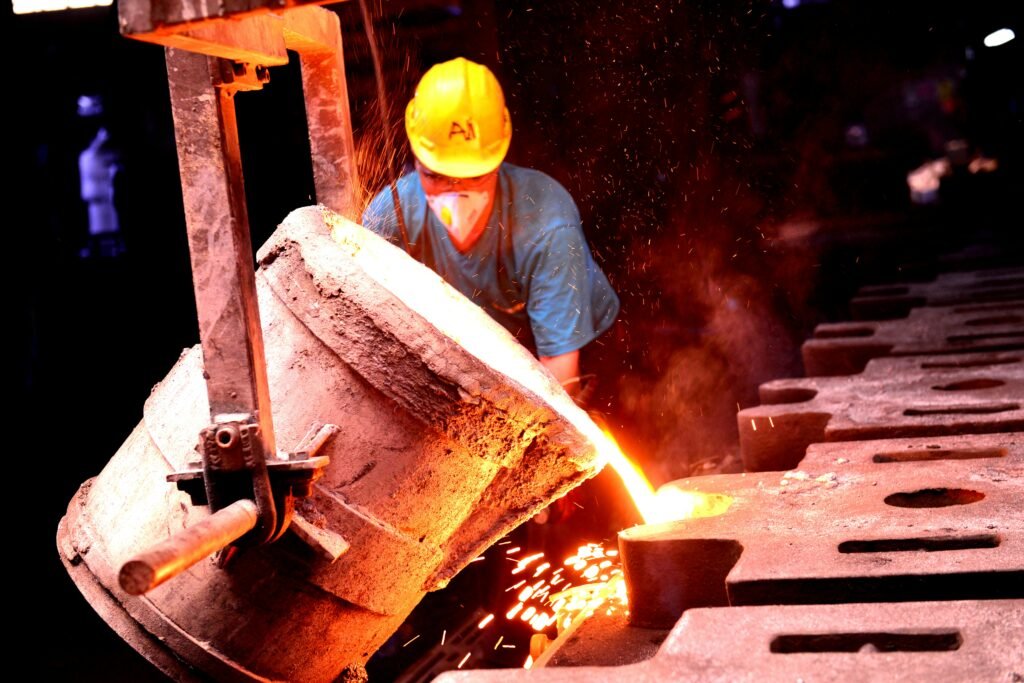Metal Casting: Introduction
Having existed thousands of years, metal casting is among the most ancient methods of manufacture. Molten metal is poured into a mold where it cools and hardens into the intended form. From materials like cast iron, aluminum, brass, and bronze, metal casting is increasingly important nowadays in producing both simple daily objects and sophisticated industrial equipment.
Metal Casting History
When bronze tools and weapons first emerged in Mesopotamia circa 3200 BCE, metal casting started in ancient times. Though its basic idea using molds to shape molten metal this method has changed dramatically. From early societies to today’s innovative companies, metal casting has been the backbone of invention.
Why Metal Casting Matters in Current Manufacturing
Metal casting is not only a classic method. For sectors including construction, aircraft, and automotive, it is absolutely vital. The adaptability of various metal forms presents countless production opportunities. From big structural components to minor engine bits, casting has become a pillar of modern manufacturing.
Kinds of Metal Casting Techniques
Sand Casting
Sand casting, among the most often used techniques, makes use of molds based on sand. It’s perfect for big, complex sections and quite adaptable in terms of material choice.
Die Casting
Die casting is high pressure molten metal forced into a steel mold. Particularly in aluminum and zinc, it produces smooth, exact surfaces and is perfect for high volume manufacture.
Investment Casting
Investment casting, sometimes referred to as lost-wess casting, is a technique for producing finely detailed components. It’s used extensively in sectors including jewelry making and aircraft manufacture.
Cast Iron: An Overview
Cast Iron’s Characteristics
Strength, dependability, and wear resistance are well-known qualities of cast iron. Although it’s heavy, it’s remarkably strong and fit for both home and industrial uses.
Uses for Cast Iron
Everything from cookware to engine blocks uses cast iron. Its robustness qualifies wood for architectural detailing, stoves, and outdoor furniture.
Aluminium Casting: Versatile and Lightweight
Aluminum Properties
Lightweight, corrosion-resistant, and with great thermal conductivity is aluminum. Applications where weight savings are crucial will find it perfect.
Applications of Cast Aluminum
In the automobile sector, aluminum castings find extensive application in engine parts, transmission housings, and wheels. Consumer goods such outdoor furniture and bike frames also feature it in great popularity.
Brass Casting: A Fusion of Strength and Beauty
Brass properties
Excellent corrosion resistance, malleability, and a gold-like appearance make brass a combination of copper and zinc rather desirable.
Common Uses for Brass
Brass is utilized in musical instruments, plumbing fittings, and decorative objects rather frequently. Its beauty and strength make it ideal for both ornamental and utilitarian use.
Bronze Casting: The Ancient Still Relevant Metal
Bronze Characteristics
Since the Bronze Age, bronze—an alloy of copper and tin has been utilized. Perfect for mechanical parts, it is robust, low friction coefficient, corrosion resistant.
Common Bronze Castings Uses
These days, bronze finds application in coins, bearings, ship fittings, and sculptures. Its present relevance as well as historical relevance are unparalleled.
Exploring the Metals: Strengths and Weaknesses
Every metal used in casting cast iron, aluminum, brass, and bronze has particular advantages. While aluminum provides light weight flexibility, cast iron is robust and weighty. Though bronze is sturdy and corrosion-resistant, brass appeals visually. The particular needs of the work determine the metal to be chosen.
The Function of Metal Casting in the Automotive Sector
Particularly for building engine components, transmission parts, and structural elements, the automotive industry mostly depends on metal casting. Particularly aluminum casting has let the sector lower weight and increase fuel economy.
The Value of Metal Casting for Aerospace
In aerospace, weight is critical; the usage of aluminum castings has transformed the design of aircraft parts. Turbine blades, engine components, and other important parts needing accuracy and strength are made from casting techniques.
Metal Casting and Construction: Strong Foundations
Construction depends much on metal casting. Often cast from iron, aluminum, or bronze are structural elements, plumbing systems, and even ornamental details. Key in developing strong infrastructure are strength, durability, and flexibility the method offers.
Metal Casting: Sustainability and Recycling
With an eye on recycling metals like aluminum and bronze, metal casting is growing more sustainable. These days, casting techniques entail melting down existing materials, cutting waste, and protecting natural resources.
Modern Metal Casting Challenges
Even if metal casting has advanced, problems still exist. Pressing problems the sector has to deal with are high energy usage, emission management, and material expenses. But as technology develops, these challenges are gradually being surmounted, guiding metal casting toward a more environmentally friendly future.
Conclusion: Metal Casting’s Future
Metal casting is more than just a historic trade-off. Offering adaptability, endurance, and creativity, modern industry depends on it fundamentally. Metal casting seems bright as new technologies develop and sustainability takes front stage.
FAQs
Using cast iron has primarily two benefits.?
Perfect for heavy-duty uses including engines and cookware, cast iron is incredibly durable, heat-resistant, and has great wear resistance.
Why is metal chosen for aeronautical and automotive components?
Lightweight yet robust, aluminum is perfect for uses where fuel economy and performance depend on weight reduction.
Can bronze and brass be recycled?
Brasses and bronze are indeed recyclable. These metals are environmentally friendly alternatives since recycling them lowers waste and helps to save resources.
What distinguishes die casting from sand casting?
While die casting employs a steel mold for high volume, precise items, sand casting uses a sand mold and is more flexible for large parts.
How may metal casting support sustainability?
By reusing former metals, cutting waste, and using energy-efficient techniques, metal casting aids sustainability.


